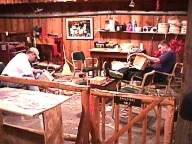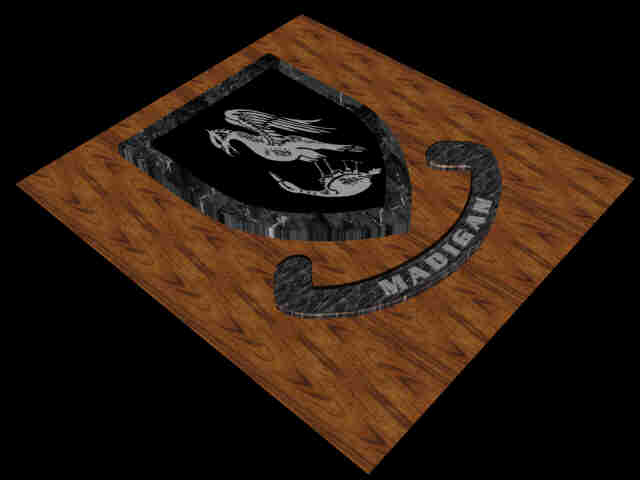College of
the Ozarks
A Different
Approach to Education
Point
Lookout, MO
March 30, 2000
 With a
week of visiting Branson Missouri behind us, and all the shows we
wanted to see already in our memory, we began to wonder what else
the area of middle America had to offer the traveler. Just a few
miles away in Point Lookout was the College of the Ozarks which
housed a small museum. As we drove onto the grounds, it was
obvious that someone had gone to great pains to create a
beautifully landscaped campus center, complete with a lake which
is home
With a
week of visiting Branson Missouri behind us, and all the shows we
wanted to see already in our memory, we began to wonder what else
the area of middle America had to offer the traveler. Just a few
miles away in Point Lookout was the College of the Ozarks which
housed a small museum. As we drove onto the grounds, it was
obvious that someone had gone to great pains to create a
beautifully landscaped campus center, complete with a lake which
is home to a gorgeous white swan, and row
after row of tulips that were just starting to open. The rolling
grass lawns were immaculate, and not so much as a piece of paper
could be found lying about anywhere on the ground. We stopped by
the administration building where we met Camille Howell, Director
of Public Relations. Generally, I prefer to avoid organizations of
learning, where getting through the often committee-led red
to a gorgeous white swan, and row
after row of tulips that were just starting to open. The rolling
grass lawns were immaculate, and not so much as a piece of paper
could be found lying about anywhere on the ground. We stopped by
the administration building where we met Camille Howell, Director
of Public Relations. Generally, I prefer to avoid organizations of
learning, where getting through the often committee-led red  tape,
required to get permission to write a story, usually takes up
most of the time available for the story. What a delight it was
to find that after a proper review of our intentions, we got
permission to go and photograph any where we wanted, with very
few restrictions. It was during this initial conversation with
Camille, that I began to understand that the College of the
Ozarks was not a typical small liberal arts college. It is a
Christian based fully-accredited four-year college founded by the
Reverend James Forsythe in 1906. Although my intent was a story
on the museum and the replica of an old grist mill, the college
itself and its no-nonsense approach to learning caught me by
surprise. The most shocking fact is that no full time student
pays a penny of tuition. However, 90% of the students must
display a financial need. This leaves the other 10% open for
students whose family income technically might be too high but
would still be good students. A lot of these slots are occupied
by children of alumni because C of O likes to feel if it
accomplishes its mission, then their alumni would otherwise be
too well off for their children to come to school here. Even room
and board is supplied to students who qualify. The second shocker
is that every student works a minimum of 15 hours a week, at any
of the 80 some odd jobs or industries operated throughout the
campus. That is their tuition. The third shocker was found in one
of the many brochures I had acquired. Only 14 percent of the
people applying for admittance are ever accepted. Those accepted
were required to demonstrate financial need, academic ability,
sound character
tape,
required to get permission to write a story, usually takes up
most of the time available for the story. What a delight it was
to find that after a proper review of our intentions, we got
permission to go and photograph any where we wanted, with very
few restrictions. It was during this initial conversation with
Camille, that I began to understand that the College of the
Ozarks was not a typical small liberal arts college. It is a
Christian based fully-accredited four-year college founded by the
Reverend James Forsythe in 1906. Although my intent was a story
on the museum and the replica of an old grist mill, the college
itself and its no-nonsense approach to learning caught me by
surprise. The most shocking fact is that no full time student
pays a penny of tuition. However, 90% of the students must
display a financial need. This leaves the other 10% open for
students whose family income technically might be too high but
would still be good students. A lot of these slots are occupied
by children of alumni because C of O likes to feel if it
accomplishes its mission, then their alumni would otherwise be
too well off for their children to come to school here. Even room
and board is supplied to students who qualify. The second shocker
is that every student works a minimum of 15 hours a week, at any
of the 80 some odd jobs or industries operated throughout the
campus. That is their tuition. The third shocker was found in one
of the many brochures I had acquired. Only 14 percent of the
people applying for admittance are ever accepted. Those accepted
were required to demonstrate financial need, academic ability,
sound character  and a willingness to work. There are
many other unique aspects of the College but I'm off in another
direction. As we passed through each of the areas we intended to
write about, I couldn't help but notice the effect this approach
had on the students. As the sign at the entrance gate proclaimed.
"Hard Work U" was evident everywhere. The attitude of
students was heartwarming. I haven't seen that many smiles or
observed that much joyous comradery before.
and a willingness to work. There are
many other unique aspects of the College but I'm off in another
direction. As we passed through each of the areas we intended to
write about, I couldn't help but notice the effect this approach
had on the students. As the sign at the entrance gate proclaimed.
"Hard Work U" was evident everywhere. The attitude of
students was heartwarming. I haven't seen that many smiles or
observed that much joyous comradery before.
Our first  stop was at Edwards Mill. This
replica of a late 1800's water-powered grist mill brings back
much of the Ozark heritage. The mill, which was the brainchild of
retired milling expert Bill Cameron, was dedicated on October 7,
of 1972. Hubert Edwards, former Chairman of the Dixie-Portland
Flour Mills Inc., and his wife, supplied the funding. A fourteen
foot waterwheel produces the 15 horsepower required to operate
the 30 inch Queen of the
stop was at Edwards Mill. This
replica of a late 1800's water-powered grist mill brings back
much of the Ozark heritage. The mill, which was the brainchild of
retired milling expert Bill Cameron, was dedicated on October 7,
of 1972. Hubert Edwards, former Chairman of the Dixie-Portland
Flour Mills Inc., and his wife, supplied the funding. A fourteen
foot waterwheel produces the 15 horsepower required to operate
the 30 inch Queen of the South
under-runner buhrs which were
manufactured over 145 years ago. It was constructed out of 200
year old timbers which had been in three other mills. The Mill
operates year round and supplies many of the job requirements for
the students. Many products are produced for public sale, and are
used by the campus in support of the students. The basement of
the mill contains a small collection of tools and is home to the
basket weaving industry. Here students gather to create an
assortment of lovely creations out of wood strips called splints
which are also produced by the students.
South
under-runner buhrs which were
manufactured over 145 years ago. It was constructed out of 200
year old timbers which had been in three other mills. The Mill
operates year round and supplies many of the job requirements for
the students. Many products are produced for public sale, and are
used by the campus in support of the students. The basement of
the mill contains a small collection of tools and is home to the
basket weaving industry. Here students gather to create an
assortment of lovely creations out of wood strips called splints
which are also produced by the students.
